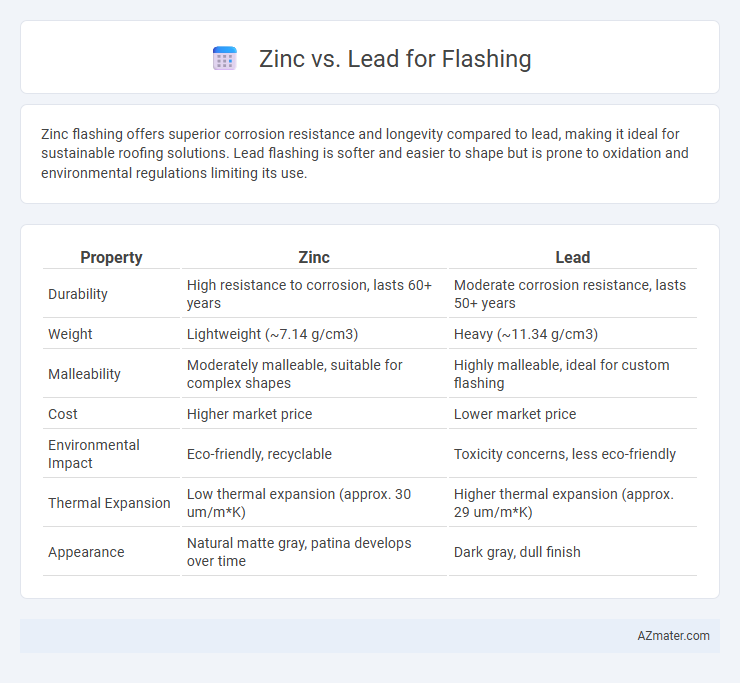Zinc flashing offers superior corrosion resistance and longevity compared to lead, making it ideal for sustainable roofing solutions. Lead flashing is softer and easier to shape but is prone to oxidation and environmental regulations limiting its use.
Table of Comparison
| Property | Zinc | Lead |
|---|---|---|
| Durability | High resistance to corrosion, lasts 60+ years | Moderate corrosion resistance, lasts 50+ years |
| Weight | Lightweight (~7.14 g/cm3) | Heavy (~11.34 g/cm3) |
| Malleability | Moderately malleable, suitable for complex shapes | Highly malleable, ideal for custom flashing |
| Cost | Higher market price | Lower market price |
| Environmental Impact | Eco-friendly, recyclable | Toxicity concerns, less eco-friendly |
| Thermal Expansion | Low thermal expansion (approx. 30 um/m*K) | Higher thermal expansion (approx. 29 um/m*K) |
| Appearance | Natural matte gray, patina develops over time | Dark gray, dull finish |
Introduction to Flashing Materials
Zinc and lead are two common metals used for flashing in construction, valued for their durability and corrosion resistance. Zinc offers a lighter weight and develops a protective patina over time, making it ideal for long-lasting weatherproofing. Lead provides excellent malleability and water resistance but is heavier and less environmentally friendly, leading to reduced usage in modern flashing applications.
Properties of Zinc Flashing
Zinc flashing offers exceptional corrosion resistance due to its self-healing patina, which prolongs its durability compared to lead flashing. Its lightweight nature and high malleability allow for easy installation and precise shaping around complex roof details. Zinc's low thermal expansion minimizes the risk of cracking and deformation, making it a superior choice for long-lasting waterproofing in construction.
Properties of Lead Flashing
Lead flashing offers exceptional malleability and corrosion resistance, making it ideal for sealing joints and preventing water infiltration in roofing applications. Its high density provides superior durability and weight, enhancing resistance to weathering and mechanical damage over time. Lead also exhibits excellent longevity, often lasting over 50 years without significant degradation, outperforming many other metals in environmental resilience.
Durability: Zinc vs Lead
Zinc flashing offers superior durability compared to lead, with a lifespan of 80-100 years due to its corrosion resistance and self-healing properties that protect against weather damage. Lead flashing, while flexible and easy to shape, typically lasts around 40-60 years but is prone to cracking and degradation under harsh environmental conditions. Zinc's ability to form a protective patina enhances its longevity, making it a more cost-effective and sustainable choice for long-term building protection.
Weather Resistance Comparison
Zinc flashing offers superior weather resistance due to its natural ability to develop a protective patina that shields against corrosion, making it highly durable in harsh climates. Lead flashing, while traditionally favored for its malleability and waterproofing, tends to oxidize and deteriorate faster when exposed to acidic rain and extreme temperature fluctuations. The long-term performance of zinc in resisting rust and environmental wear makes it a preferred choice for sustainable and low-maintenance roofing solutions.
Environmental Impact and Sustainability
Zinc flashing offers superior environmental benefits due to its recyclability and long lifespan, reducing waste and resource consumption. Lead, while durable, poses significant environmental hazards through toxic runoff and difficulties in recycling. The sustainability of zinc makes it a preferred material in eco-friendly construction practices.
Installation Process Differences
Zinc flashing requires precise heating and shaping due to its lower melting point, allowing for easier manipulation but demanding careful handling to avoid warping. Lead flashing, being denser and more malleable at room temperature, can be installed with simpler tools and less heat, offering greater flexibility in fitting complex roof shapes. The installation process for zinc often involves soldering seams, while lead typically uses pegging or folding techniques to secure the flashing.
Cost Analysis: Zinc vs Lead Flashing
Zinc flashing generally costs more upfront than lead due to higher raw material prices and fabrication complexity, yet it offers longer durability and lower maintenance expenses over time, which can result in better lifecycle value. Lead flashing has a lower initial purchase price and is easier to shape, but it tends to degrade faster, potentially leading to more frequent replacements and higher cumulative costs. Evaluating total cost of ownership, zinc often proves more economical for long-term roofing projects despite its higher initial investment.
Maintenance and Longevity
Zinc flashing offers superior longevity, typically lasting over 80 years due to its natural patina that protects against corrosion, significantly reducing maintenance needs. Lead flashing, while historically favored for its malleability, tends to oxidize and can develop cracks over time, requiring more frequent inspections and repairs. Choosing zinc for flashing enhances durability and minimizes long-term upkeep costs in roofing applications.
Choosing the Best Flashing Material
Zinc flashing offers superior durability and natural patina formation, providing long-lasting protection against corrosion and weathering compared to lead flashing. Lead flashing, while historically favored for its malleability and ease of installation, poses environmental and health concerns due to its toxicity. Selecting zinc flashing ensures compliance with modern building regulations and sustainability standards, making it the preferred material for high-performance and eco-friendly roofing applications.

Infographic: Zinc vs Lead for Flashing
 azmater.com
azmater.com